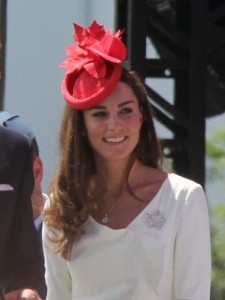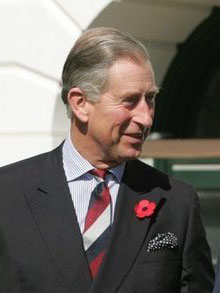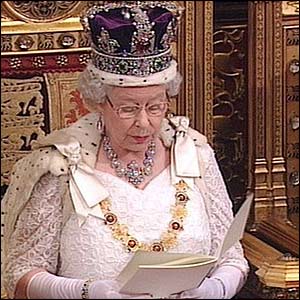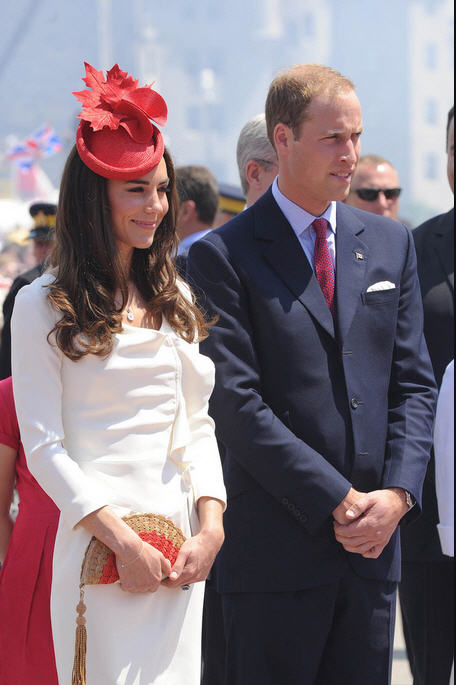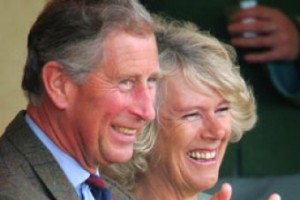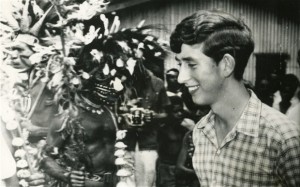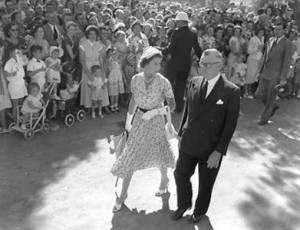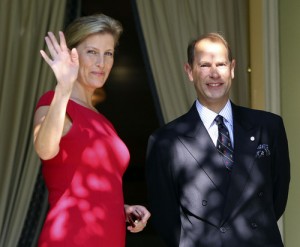My latest interview for Yahoo Shine Canada discusses the wide range of official duties performed by royalty today. Since the reign of King George III, philanthropy has been a key role for royalty, especially princesses. Queen Victoria’s five daughters all assumed charitable patronages, many of which were devoted to the health and education of women and girls. Today, representing Queen Elizabeth II at official engagements is also an important role for members of the royal family. The Queen and Prince Philip have reduced their overseas travel in recent years and their children and grandchildren often represent them outside the United Kingdom.
Category Archives: Diamond Jubilee Tours 2012
The Crown and Canadian Federalism by D. Michael Jackson (Review)





For readers interested in personalities as well as politics, Jackson provides plenty of fascinating anecdotes about how Lieutenant Governors and Governors General engaged with their governments and the public over the past few centuries. Despite the importance of political impartiality for representatives of the Crown, several Lieutenant Governors found themselves in conflict with the governments elected during their tenure.
Examples include Lieutenant Governor John Bowen of Alberta, who was turned out of Government House in Edmonton by Premier William Aberhart in 1938 for reserving royal assent to legislation and Lieutenant Governor Frank Bastedo of Saskatchewan, a former counsel for the oil industry accused of conflict of interest when he reserved royal assent on Bill 56, The Alteration of Certain Mineral Contracts, in 1961. In contrast to these contentious figures, Jackson describes Bastedo’s successor as Lieutenant Governor of Saskatchewan, my great granduncle Robert Leith “Dinny” Hanbidge as “informal, low-key and non-controversial” during his seven year term from 1963 to 1970.

Upcoming Guest Lecture About Queen Elizabeth II in Canada
I will be delivering a guest lecture about the Queen in Canada on June 21 at 2pm at the Don Mills Public Library in Toronto.
Representing the Queen: The Prince of Wales to Attend Commonwealth Heads of Government Meeting in 2013
Buckingham Palace announced this week that the Prince of Wales will represent his mother, Queen Elizabeth II, at the Commonwealth Heads of Government Meeting (CHOGM) this fall in Colombo, Sri Lanka. The Queen is committed to her role as Head of the Commonwealth and has attended every one of these biennial meetings since 1971. The decision to send the Prince of Wales to Sri Lanka as the Queen’s representative in 2013 demonstrates that the 87 year old monarch is gradually reducing her overseas travel. In 2012, the Queen and the Duke of Edinburgh toured the United Kingdom in honour of the Diamond Jubilee while their children and grandchildren visited all the commonwealth realms to mark the occasion. The Prince of Wales’s representation of the Queen at the 2013 CHOGM is part of the broader pattern. Click here for my interview with Janet Davison of CBC about the significance of the Prince of Wales attending CHOGM on the Queen’s behalf.
The Prince of Wales’s visit to Sri Lanka is also an example of the Queen carefully preparing her heir, and public opinion in both the United Kingdom and the Commonwealth realms, for a seamless transition between this reign and the next one. Queen Elizabeth, the Queen Mother lived to age of 101 and there is no reason to believe that the current Queen will not continue to reign for years to come but there is evidence that the Prince of Wales’s public role will continue to expand in the coming years in anticipation of his eventual ascension to the throne.
Prince Charles has participated in a number of high profile public engagements and commonwealth tours in 2012 and 2013. The role of Head of the Commonwealth is not hereditary. The Prince’s successful Diamond Jubilee tours of Canada, Australia and New Zealand in 2012 and attendance at CHOGM in 2013 affirm his commitment to eventually assuming this role and increase the likelihood that the Commonwealth Heads of Government will choose him as Elizabeth II’s successor as Head of the Commonwealth
Today, May 8, the Prince of Wales accompanied the Queen to the State Opening of Parliament at Westminster with the Duchess of Cornwall, the first time he has attended this event in 17 years. While the attendance of the Prince and Princess of Wales at State Openings of Parliament in the 1980s received public attention because of Diana’s fashions, the 2013 event showcases Charles in his role as future King.
Although Prince Charles’s reputation has improved considerably in recent years with greater public interest in his philanthropic and environment initiatives, successive opinion polls demonstrate that his mother, the Queen, and his sons, Prince William and Prince Harry remain more popular with the general public in both the United Kingdom and Commonwealth. The Prince of Wales’s second marriage to the former Camilla Parker-Bowles, his willingness to express his political opinions publicly and his increasing age have all prompted concerns about his suitability to become King. Prince Charles’s presence at high profile events such as the 2013 CHOGM and the State Opening of Parliament are all opportunities to demonstrate to the public that he has the experience and stature to serve as Head of State for sixteen nations in the twenty-first century.
As a young Princess, the current Queen experienced a similar “apprenticeship” from her father, King George VI that showcased her ability to effectively reign as a constitutional monarch through public engagements, wartime service and commonwealth tours. As Prince William explained to Robert Hardman in the 2011 book, Our Queen, “Back then there was a different attitude toward women. Being a young lady at twenty-five – and stepping into a job which many men thought they could probably do better – it must have been very daunting. And I think there was extra pressure for her to perform.”
George VI ensured that his elder daughter had the necessary training to overcome any skepticism about her ability to fulfill her constitutional role. Beginning in 1939, the thirteen year old Princess studied the history and structure of the British political system with Henry Marten, the Vice Provost of Eton College. During the final year of the Second World War, Elizabeth served at the Mechanical Transport Training Centre run by the Auxiliary Transport Service.
Princess Elizabeth completed her first commonwealth tour with the King and Queen in South Africa in 1947 then represented her father in Canada in 1951 and Kenya in 1952. If King George VI had not died in 1952 at the comparatively young age of fifty-six, this period of apprenticeship would have continued for decades in the manner of the current Prince of Wales’s preparation for his eventual ascension.
The Prince of Wales’s attendance at the 2013 Commonwealth Heads of Government Meeting as the Queen’s representative is part of a broader program of public events that present him to the public in his role as future King. Charles’s recent Diamond Jubilee Commonwealth Tours and presence at the 2013 State Opening of Parliament all demonstrate that he has been carefully prepared for the role of future monarch and that the Queen is planning for a seamless transition between her reign and that of her eldest son.
Harry: The People’s Prince by Chris Hutchins (Review)


The sections of Harry: The People’s Prince concerning Harry’s military service are the strongest chapters of the book. Hutchins combines the Prince’s extensive and occasionally controversial interviews about Afghanistan with quotes from his fellow soldiers and royal observers, giving a sense of Harry’s commitment to his military duties and daily life during his tours of duty. Hutchins also discusses Harry’s relationship with Chelsy Davy in more detail than previous works, revealing the full extent of her influence over key years in Harry’s life. Chelsy even edited Harry’s best man speech at Prince William’s wedding to Kate Middleton in 2011, removing jokes that might offend the Queen.


British monarchs led troops into battle until the mid eighteenth century and military service has long been accepted avenue for channeling the energies of a “party prince.” Readers of Harry: The People’s Prince should also read a work about royalty at war, such as Charles Carlton’s Royal Warriors: A Military History of the British Monarchy, to get a better sense of Harry’s place in the long tradition of royalty in the military.


Harry’s very popularity may preclude a life of comparative obscurity abroad. Queen Elizabeth II, the Prince of Wales and Prince William will need “The People’s Prince” to continue his rapport with the public throughout all sixteen commonwealth realms. Harry: The People’s Prince is an interesting biography of a popular prince that would be improved by greater historical context for his military exploits and future, and less attention to the well known story of the Prince and Princess of Wales’ divorce.
Comparing the Constitutional Monarchies of the Countries on Prince Charles’s November Itinerary: Papua New Guinea, Australia and New Zealand
Prince Charles and the Duchess of Cornwall are currently in Australia as part of a two week tour of Papua New Guinea, Australia and New Zealand to celebrate Queen Elizabeth II’s Diamond Jubilee. This tour marks the Duchess of Cornwall’s first visit to these countries but Prince Charles has a long history of involvement in the region. In 1966, he spent two terms at Geelong Grammar School in Australia as an exchange student from the Gordonstoun School in Scotland. As part of his studies, the Prince traveled to Papua New Guinea with his history tutor to learn about the history and culture of this unique commonwealth realm. The Diamond Jubilee tour therefore celebrates the Prince’s decades of interest and involvement in the region as well as the Queen’s 60 year reign.
The three commonwealth realms on the royal couple’s itinerary may share Queen Elizabeth II as head of state but they have distinct systems of constitutional monarchy. Popular perceptions of the royal family and royal tours, both in previous decades and today, also differ amongst Papua New Guinea, Australia and New Zealand.
In Papua New Guinea, there is widespread popular admiration for “Misis Kwin” as Elizabeth II is known in the local creole language, Tok Pisin. Papua New Guinea gained independence from Australia in 1975 but retained the Queen as its Head of State. In contrast to the other commonwealth realms, where the Queen’s representative, the Governor General, is nominated by the Prime Minister, the parliament of Papua New Guinea elects the nominee for Her Majesty’s approval. This collaborative system for selecting the Governor General undoubtedly contributes to the monarchy’s popularity.
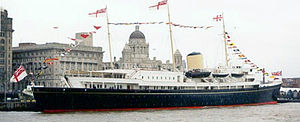
The Royal Yacht Britannia, now a museum ship in Edinburgh. Before it was decommissioned in 1997, the yacht facilitated royal visits to island commonwealth realms such as Papua New Guinea
The Duke of Edinburgh, known in Tok Pisin as “oldfella Pili-Pili him bilong Misis Kwin” visited the island as part of an extensive commonwealth tour of the region in 1956-1957 that included opening the Summer Olympics in Melbourne, Australia. The Queen’s most extensive visit to Papua New Guinea occurred during her Silver Jubilee tour in 1977 when she visited the capital, Port Moresby, Popondetta and Alotau.
In common with Tuvalu and the Solomon Islands, commonwealth realms visited by the Duke and Duchess of Cambridge this year, Papua New Guinea experienced fewer royal visits after the Royal Yacht Britannia was decommissioned in 1997. Prince Charles and the Duchess of Cornwall’s visit this week has been greeted by cheering crowds and the Prince’s decision to introduce himself in the local language as the “nambawan pikinini bilong Misis Kwin” (The number one child belonging to Mrs Queen) endeared him to the people of Papua New Guinea.
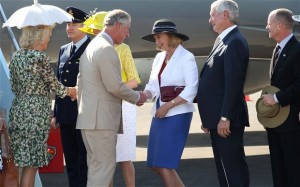
Prince Charles greeting Governor of Queensland Penelope Wensley upon his arrival in Australia. Photo credit: Tertius Pickard/AFP/Getty Images
The history of popular perceptions of the monarchy in Australia is more complicated, encompassing both extreme enthusiasm for the royal family and republican sentiment. The first royal tour of Australia, by Queen Victoria’s second son Prince Alfred, Duke of Edinburgh, in 1868, was marked by the first political assassination attempt in Australian history. The Prince was shot and wounded in the back by Irish-Australian law clerk Henry James O’Farrell necessitating a two week hospital stay before his departure.
Mishaps also occurred during royal tours of Australia in the 20th century. When the future Edward VIII visited in 1920 to thank Australians on behalf of his father, King George V, for their contributions to the First World War, his railway carriage overturned. The Prince was unhurt and made light of the incident, calling it a The Prince was unhurt and made light of the incident, calling it a ‘harmless little railway accident.’ More serious injuries occurred in Melbourne in 1954, when the enormous crowd that gathered to greet Elizabeth II on her first visit to Australia broke through police barricades. According to the Adelaide newspaper, “The Advertiser,” “Screaming women added to the tumult and some who were trampled on had to be treated by St. John Ambulance Officers.”
More recently, Australia has debated changing its government from a constitutional monarchy to a Republic. In 1999, a referendum proposing that Australia cut ties with the monarchy was defeated by 55% of the popular vote. At the time, Republican sentiment was divided by whether the Governor General would be replaced by a President nominated by the Prime Minister or by popular vote. A 2011 poll, however, revealed that support for constitutional change is the lowest it has been for twenty years. Of those surveyed, only 34% were pro-republic as opposed to 55% pro-monarchy, suggesting that the monarchy’s popularity has increased in the twenty-first century.
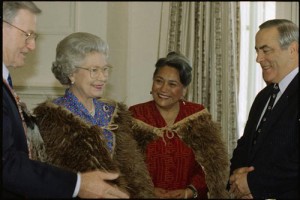
Queen Elizabeth II wearing a traditional kiwi feather cloak while giving royal assent to the Waikato Raupatu Claims Settlement Act 1995
Queen Elizabeth II’s role as Head of State has been much less controversial in New Zealand. The existence of the modern state of New Zealand dates from the signing of the Treaty of Waitangi in 1840 when over 400 Maori chiefs granted Queen Victoria sovereignty over what is now New Zealand in exchange for recognition of their land rights and receiving the status of British subjects. The Crown is therefore integral to the history of the modern state, particularly the property rights of the Maori people. Royal visits to New Zealand have been well received in the past. The Queen has visited on ten occasions and has included words of the Maori language in her speeches at Maori welcoming ceremonies, reaffirming the historic relationship between the crown and New Zealand’s first peoples.
Prince Charles’s Diamond Jubilee tour of Papua New Guinea, Australia and New Zealand encompasses three distinct constitutional monarchies that share Queen Elizabeth II as Head of State. The monarchy has been embraced as part of the national character of Papua New Guinea and New Zealand and royal visits there have traditionally been well received. Australia has gone through periods of republican sentiment and popular reactions to royal tours have ranged from an 1868 assassination attempt to a 1954 stampede by thousands of enthusiastic Australians. Recent polling data suggests that Australians are once again embracing the constitutional monarchy and will provide a warm welcome for the Prince of Wales and Duchess of Cornwall.
Guest Lecture on The Queen’s Image: Elizabeth II and the Media from 1952 to 2012 at the Spadina Museum, Toronto, October 23, 2012
The Duke of Kent Celebrates Two Jubilees in Uganda
Queen Elizabeth II’s cousin, Prince Edward, Duke of Kent is currently in Uganda where he will celebrate two jubilees on October 9. The Duke’s visit to Uganda is part of the celebration of the Queen’s Diamond Jubilee, which has seen members of the royal family travel to all commonwealth nations to mark the monarch’s sixty year reign. For Uganda, 2012 marks the 50th anniversary of full independence from the United Kingdom, the nation’s Golden Jubilee. The Duke of Kent represented the Queen at the independence ceremonies in Uganda’s capital, Kampala, in 1962 and his presence represents the continuity of his interest in this African nation. October 9 is also the Duke’s birthday. The Duke’s busy schedule of royal engagements and tours also demonstrates the importance of the Queen’s extended family to her relationship with the global commonwealth.
Following the death of Queen Victoria and the ascension of Edward VII in 1901, the number of members of the royal family performing official duties began to contract. Queen Alexandra assumed charitable patronages previously held by Edward’s sisters, Princesses Helena, Louise and Beatrice. In an era when overseas royal visits were rare, a smaller royal family appeared to suit public needs.

A 1917 Punch cartoon entitled "A Good Riddance" showing King George V sweeping away his family's German titles
The process of streamlining the royal family was formalized in 1917 when King George V decreed that only children or male line grandchildren would be Princes or Princesses addressed as His or Her Royal Highness. The German royal titles of many members of the King’s extended family were abolished and replaced with titles that placed them within the English aristocracy. For the younger children and grandchildren of Queen Victoria resident in the United Kingdom, the reigns of George V and George VI marked their gradual withdrawal from royal engagements and life in the public eye.
By the time Queen Elizabeth II ascended to the throne in 1952, the public role of the royal family had expanded to encompass frequent personal visits to the Commonwealth, which expanded rapidly in the 1950s and 1960s as the decolonization of the former British Empire accelerated. The new Queen took her role as Head of the Commonwealth seriously and was determined to increase the royal family’s personal relationship with this global group of nations. To achieve this goal, the Queen reversed the streamlining of the royal family enacted by her predecessors and actively involved her royal first cousins, Prince Edward, Duke of Kent, Princess Alexandra, Prince Michael of Kent and Richard, the present Duke of Gloucester in public engagements and tours.
Queen Elizabeth’s ascension therefore marked the beginning of Edward’s long career of public service. The sixteen year old Duke, who had inherited the title on the death of his father Prince George, (younger brother of Edward VIII and George VI), in an airplane crash in 1942, walked behind George VI’s coffin and swore allegiance to Elizabeth II at her coronation. Following his graduation from Eton, Edward enrolled at Sandhurst, the beginning of a long military career that included a tour in Hong Kong and command of a squadron serving in Cyprus as part of a United Nations force in 1970. Following his retirement from the military in 1976, Edward assumed the role of Vice Chairman of British Trade International, a position he held until 2001.
Although Edward’s 1961 wedding to Katharine Worsley, at York Minster cathedral, which had not been the setting of a royal wedding since the Middle Ages, had raised his public profile in the United Kingdom, Edward was not well known internationally until he represented the Queen at a series of independence ceremonies for new commonwealth nations including Sierra Leone, Uganda, Guyana and The Gambia. As royal historian Hugo Vickers has recently written, Uganda’s first executive Prime Minister Milton Obote did not consider the Duke of Kent to be a sufficiently senior member of the royal family to represent the Queen when Uganda formalized its independence, describing Edward as “a young man and totally unknown in Uganda.”
Despite the skepticism that greeted his arrival in Uganda for the independence celebrations, the Duke received popular acclaim for his speech, which expressed his admiration for the Ugandan people and hopes for the newly independent nation. Edward stated, “This lovely country which is your home was once aptly described as “a fairy tale” – a description given to it by one of the greatest men of our time, Sir Winston Churchill, who came to Uganda nearly sixty years ago. In Uganda, he continued, “There is discipline, there is industry, there is peace”. And, “From end to end, it is one beautiful garden.”
It was a well-deserved tribute, as my wife and I have been able to see for ourselves; it is now in your hands to preserve this good repute; to ensure that your country’s name is respected by other nations, not only in the vast Continent of Africa but throughout the world, and to build it into a nation that is envied everywhere for its stability, and for its happiness.” The full text of the Duke of Kent’s 1962 speech is available here.
Sadly, the people of Uganda experienced little stability or happiness during the first fifty years following independence. Obote was deposed in 1971 and replaced by the military dictator Idi Amin, whose eight year reign of terror resulted in the mass killings of 300,000 Ugandans. More recently, the civil war between the Ugandan government and Joseph Kony’s Lord’s Resistence Army, which is notorious for the use of child soldiers, has killed thousands and displaced millions. On the occasion of the fiftieth anniversary of independence, many Ugandans have expressed disappointment in the current state of the country.
The combined celebration of the Queen’s Diamond Jubilee and Uganda’s Golden Jubilee provides an opportunity for Uganda to begin a new chapter in its history. The stability and happiness predicted by the Duke of Kent in 1962 may finally occur in the twenty-first century as Uganda gradually rebuilds after decades of warfare. The Duke of Kent’s presence for the fiftieth anniversary of Ugandan independence represents the continuity of the monarchy’s relationship with this troubled commonwealth nation and the royal family’s hopes that the next fifty years will bring more stability and happiness to Uganda.
The Countess of Wessex Attends the Toronto International Film Festival
The Earl and Countess of Wessex began their 2012 Toronto engagements this evening with a visit to the Toronto International Film Festival. The Countess of Wessex attended a Diamond Jubilee medal presentation and TIFF reception at the Lieutenant Governor’s
Suite in Queen’s Park, the legislative building for the province of Ontario at 6pm. Canadian Filmmaker Atom Egoyan, and Festival Directors Piers Handling and Michèle Maheux each received the medal for their contributions to Canadian arts and culture. At 9pm, the Countess will attend a screening of Rebelle, by Canadian director Kim Nguyen at the Elgin & Winter Garden Theatre.
Rebelle is a drama about Komona, a twelve year old girl forced to become a child soldier in the Democratic People’s Republic of the Congo and her attempts to overcome her tragic circumstances. Lead actress Rachel Mwanza received a Best Actress Prize at the Berlin Film Festival and the most non- professional cast has been praised by critics for their authentic performances. The Earl and Countess of Wessex both have a strong interest in the welfare of children worldwide. In 1999, they founded the Wessex youth trust, which provides funding for organizations that help children in need. The choice of film reflects the couple’s interest in improving the lives of young people.
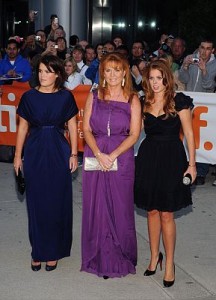
The Duchess of York, Princess Beatrice and Princess Eugenie at the premiere of The Young Victoria in 2009. Photo Credit: Brent Perniac/AdMedia/KEYSTONE Press
The Toronto International Film Festival has seen royalty on the red carpet on previous occasions. In 2009, Sarah, Duchess of York and her daughters Princess Beatrice and Princess Eugenie attended the premiere of The Young Victoria at Royal Thompson Hall. The Duchess of York co-produced the film with Martin Scorsese and Princess Beatrice had a prominent cameo as one of Queen Victoria’s ladies-in-waiting. During their visit to Toronto, the Princesses took the opportunity to shop and see the sights incognito, visiting the Yorkville Club Monaco and the Royal Ontario Museum.
The Earl of Wessex has a longstanding interest in film and the theatre. Instead of pursuing a military career like his elder brothers Prince Charles and Prince Andrew, Prince Edward pursued jobs in the arts. In 1988, he joined Andrew Lloyd Webber’s Really Useful Group as a production assistant.
Edward’s work inspired a personal visit to Toronto in 1989, when the Prince attended the premiere of the Phantom of the Opera. After working for another theatre company, Theatre Division, Edward founded his own television production company, Ardent Productions, in 1993. Ardent produced a broad range of programs, most notably documentaries about King Edward VIII and the restoration of Windsor Castle after the 1992 fire, but experienced financial difficulties. Both the Earl and Countess began a full schedule of royal duties with the Golden Jubilee in 2002 but the couple’s artistic interests continue to influence the itineraries of their official, working and personal visits.
The Earl and Countess of Wessex will attend further engagements in Toronto on Monday, September 17. They will accompany Lieutenant Governor of Ontario, David Onley to a 2015 Pan/ParaPan American Games briefing in the morning. The Earl has a strong interest in youth athletics through his patronage of the Duke of Edinburgh Award program and this briefing is an opportunity for the royal couple to engage with planning of the 2015 Games in Toronto.
In the afternoon, the Earl will preside over a Duke of Edinburgh Community Showcase & Gold Award Ceremony while the Countess visits with Roots of Empathy, a charity that focuses on reducing bullying in the classroom. The Earl and Countess of Wessex’s visit to the Toronto International Film Festival is the start of a busy program of events in Toronto that reflect the royal couple’s artistic interests and charitable patronages.
Interview with ABC Radio Australia about the Duchess of Cambridge
I will be speaking with ABC Radio Australia on September 14 at 8am EST to discuss the Duchess of Cambridge’s upcoming meeting with women’s groups in the Solomon Islands. The interview will be broadcast on Monday. Click here to listen online.
